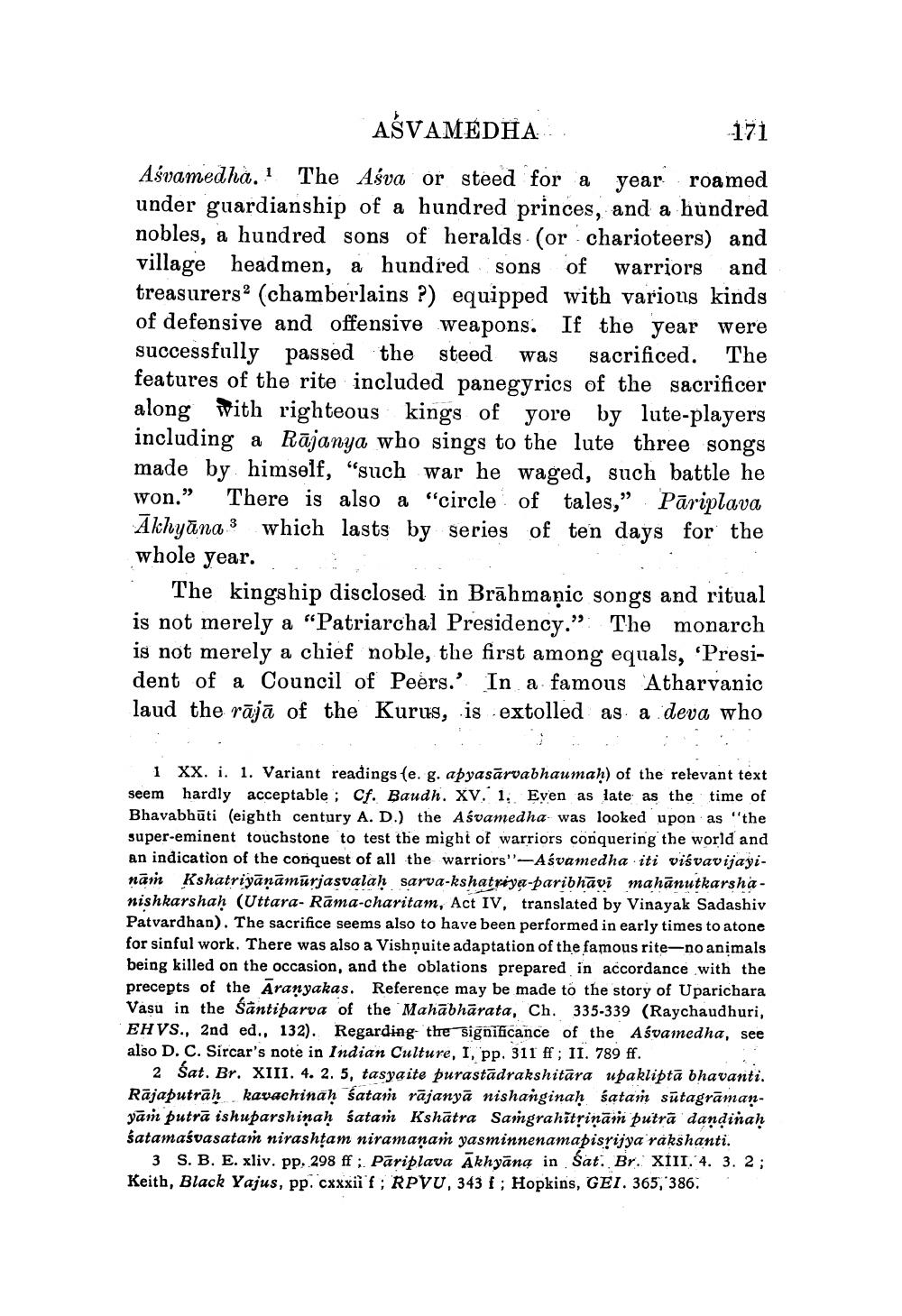________________
AŠVAMEDHA
171 Ašvamedhà." The Aśva or steed for a year roamed under guardianship of a hundred princes, and a hundred nobles, a hundred sons of heralds (or charioteers) and village headmen, a hundred sons of warriors and treasurers? (chamberlains ?) equipped with varions kinds of defensive and offensive weapons. If the year were successfully passed the steed was sacrificed. The features of the rite included panegyrics of the sacrificer along with righteous kings of yore by lute-players including a Rājanya who sings to the lute three songs made by himself, “such war he waged, such battle he won.” There is also a "circle of tales," Pāriplava Akhyāna 3 which lasts by series of ten days for the whole year...
The kingship disclosed in Brāhmaṇic songs and ritual is not merely a "Patriarchal Presidency.". The monarch is not merely a chief noble, the first among equals, 'President of a Council of Peers.' In a famous Atharvanic laud the rājā of the Kurus, is extolled as a deva who
1 XX. i. 1. Variant readings (e. g. apyasārvabhaumah) of the relevant text seem hardly acceptable; cf. Baudh. XV. 1, Even as late as the time of Bhavabhūti (eighth century A. D.) the Aśvamedha was looked upon as "the super-eminent touchstone to test the might of warriors conquering the world and an indication of the conquest of all the warriors''-Aśvamedha iti viśvavijayinām Kshatriyāņāmūrjasvalah sarva-kshatriya-paribhāvi mahānutkarsha - nishkarshah (Uttara- Rāma-charitam, Act IV, translated by Vinayak Sadashiv Patvardhan). The sacrifice seems also to have been performed in early times to atone for sinful work. There was also a Vishņuite adaptation of the famous rite-no animals being killed on the occasion, and the oblations prepared in accordance with the precepts of the Aranyakas. Reference may be made to the story of Uparichara Vasu in the Santiparva of the Mahābhārata, Ch. 335-339 (Raychaudhuri, EHVS., 2nd ed., 132). Regarding the significance of the Aśvamedha, see also D. C. Sircar's note in Indian Culture, I, pp. 311 ff; 11. 789 ff.
2 Sat. Br. XIII. 4. 2. 5, tasyaite purastādrakshitāra upakliptā bhavanti. Rājaputrāh kavachinaḥ śatai rājanya nishanginaḥ śatam sūtagrāmanyām putrā ishuparshinaḥ śatam Kshātra Samgrahitrinām putrā dandinah śatamasvasatan nirashtam niramanam yasminnenamapisrijya rakshanti.
3 S. B. E. xliv. pp. 298 ff : Pāriplava Akhyāna in Sat. Br. XIII. 4. 3. 2; Keith, Black Yajus, pp. cxxxii f; RPVU, 343 f ; Hopkins, GEI. 365, 386.




